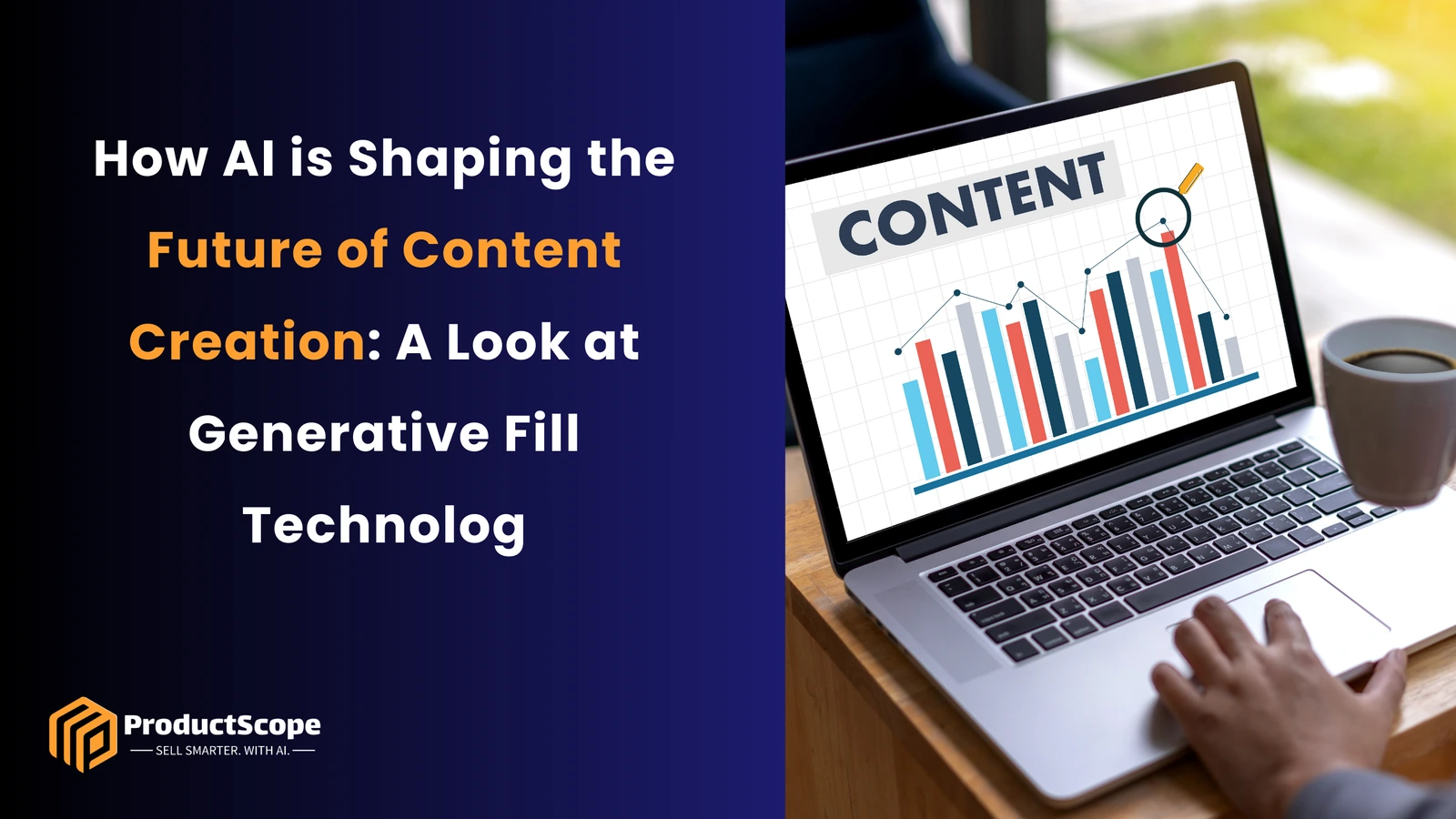Artificial intelligence is transforming the landscape of content creation, ushering in a new era of efficiency, creativity, and scalability. At the forefront of this revolution is Generative Fill Technology, a groundbreaking innovation that’s reshaping how we produce and consume digital content.
This article delves into how AI is shaping the future of content creation, with a particular focus on Generative Fill Technology and its far-reaching implications.
Key Takeaways
- AI streamlines content creation processes by automating drafting, editing, and optimization.
- AI-powered tools enhance creativity by offering new ideas and structures for content creators.
- Businesses can now produce professional-grade content without needing specialized teams.
- AI-driven platforms are transforming e-commerce by revolutionizing product photography and marketing strategies.
What is Generative Fill Technology?
Generative Fill Technology represents a significant leap forward in AI-powered content creation. At its core, this technology uses advanced machine learning algorithms to analyze existing content and generate new, contextually relevant material. Whether it’s text, images, or even video, Generative Fill can seamlessly expand or enhance content based on user input and learned patterns.
Key players in the Generative Fill space include OpenAI’s GPT-3, Adobe’s Sensei, and NVIDIA’s GauGAN. These platforms leverage vast datasets and sophisticated neural networks to produce human-like content at unprecedented speeds and scales.
The Impact of AI on Content Creation Processes

AI is revolutionizing content creation workflows in several key ways:
Streamlining Production
AI tools are transforming the content creation landscape by automating much of the drafting and editing process. These tools can analyze vast amounts of data, detect trends, and generate comprehensive drafts, outlines, or even complete articles within minutes. By handling tasks that traditionally took hours or even days, AI significantly reduces the time-to-market for content, enabling creators to focus more on strategy and fine-tuning rather than mundane tasks.
With advanced machine learning algorithms, AI can also optimize content based on SEO best practices, ensuring better performance across digital platforms without requiring constant manual updates.
Enhancing Creativity
AI serves as a valuable asset for creators by acting as a creative companion. Rather than replacing human creativity, it enhances it by offering fresh ideas, content structures, and even topic suggestions that may not have been immediately considered.
AI tools like GPT models, for instance, can generate multiple variations of a headline or opening paragraph, helping writers overcome creative blocks. This ability to assist with brainstorming ensures that content remains innovative and dynamic, giving creators the freedom to explore new angles and approaches more confidently.
Democratizing Content Creation
Historically, producing high-quality content required expensive tools, a specialized team, or a significant time investment. However, user-friendly AI-powered tools have leveled the playing field. Now, individuals and small businesses can create professional-grade content at a fraction of the cost and time, even without a background in writing, design, or video production.
With intuitive interfaces and automated workflows, these tools empower users to produce compelling articles, social media posts, videos, and other media with minimal technical expertise, expanding the pool of creative talent and lowering the barriers to entry in digital content creation.
AI-Powered Content Creation Tools
The market for AI-driven content creation tools is expanding rapidly, offering solutions for various media types and catering to industries ranging from marketing to entertainment.
Text Generation
Platforms like ProductScope AI Agents and Copy.ai are transforming the way businesses and content creators approach writing. These tools use natural language processing (NLP) models to assist with a variety of tasks, such as drafting blog posts, crafting marketing copy, and even generating product descriptions.
The algorithms are designed to mimic human-like writing patterns, allowing users to choose tones, structures, and keywords that align with their brand voice. As a result, businesses can scale their content output, increase SEO effectiveness, and maintain consistent messaging across platforms without sacrificing quality.
Image and Graphic Design
AI-powered tools like ProductScope AI Photoshoot and Midjourney have revolutionized image and graphic design by transforming text prompts into stunning visuals. These AI models can generate detailed, realistic, or abstract images based on a few descriptive keywords, making them indispensable for e-commerce, advertising, and social media marketing.
Whether it’s generating product images for an online store, creating eye-catching marketing materials, or designing social media content, these platforms significantly reduce the time and cost associated with traditional design workflows. By leveraging AI, businesses can produce custom visuals at scale without the need for a professional designer.
Video and Animation
Creating engaging video content is no longer an arduous process thanks to AI tools like Synthesia and Lumen5. These platforms allow users to produce professional-looking videos with minimal human input. Synthesia, for example, uses AI avatars and synthetic voices to narrate videos, making it ideal for corporate training, explainer videos, and even personalized marketing.
Meanwhile, Lumen5 automates the video creation process by converting text-based content into visually appealing video presentations, perfect for social media marketing, blogs, and promotional campaigns. Both tools enable businesses to scale video production without the need for expensive equipment or specialized talent.
Audio and Music
AI in audio production has opened up new possibilities for creative sound design. Platforms like Amper Music and AIVA allow users to compose original soundtracks, background music, and jingles without requiring any musical expertise. Amper Music uses AI to generate music based on user-defined parameters such as mood, genre, and tempo, making it a perfect tool for creators looking to add custom audio to podcasts, advertisements, and videos.
AIVA focuses on creating emotionally resonant soundtracks, widely used in video games, film scoring, and background music for commercials. These AI music generators are transforming the music industry by democratizing access to composition tools, allowing individuals and businesses to create high-quality audio content affordably.
Natural Language Processing (NLP) and Chatbots
In addition to content creation, AI is enhancing customer engagement through NLP-powered chatbots and virtual assistants like OpenAI’s GPT models and Google’s Dialogflow. These tools can handle customer inquiries, assist with onboarding, or provide recommendations, all while delivering personalized, real-time responses.
Integrating these AI-driven chatbots into websites, apps, or customer support channels streamlines customer interactions, improves user experiences, and reduces operational costs.
Content Personalization and Optimization
AI tools like Surfer SEO and MarketMuse are helping businesses not only generate content but also optimize it for better visibility and engagement. These platforms use machine learning to analyze search trends, content gaps, and competitive rankings, suggesting improvements to existing content while assisting in the creation of high-performing new articles.
The ability to personalize content based on user behavior, preferences, and market trends is transforming digital marketing strategies, making it easier for businesses to tailor their messaging to individual users.
The Role of AI in Content Strategy and Planning

Beyond creation, AI is playing an increasingly important role in content strategy:
Topic Generation
AI has transformed how marketers and content creators approach topic generation. By analyzing large volumes of search trends, user behavior, and social media conversations, AI can identify gaps in content and suggest topics that are highly relevant to target audiences.
These tools not only save time but also ensure that the content created is timely and tailored to audience interests, increasing engagement and visibility.
Performance Prediction
Machine learning models can now analyze historical data to predict how future content will perform. By evaluating factors such as keyword difficulty, audience preferences, and even external variables like market trends, AI can forecast metrics like click-through rates (CTR), engagement levels, and conversion rates.
This allows marketers to make informed decisions on content strategies, optimizing resources for the most impactful outcomes and reducing the risk of failed campaigns.
Audience Insights
AI-powered tools can segment audiences based on demographics, behavior, and psychographics to create detailed personas. These insights help content strategists understand not just who their audience is, but also what they are looking for.
AI tools can detect nuances in behavior, such as which types of content formats resonate best with certain groups (e.g., video vs. blog posts), or what time of day content should be posted to maximize engagement. This granularity allows for hyper-targeted content strategies that align with audience needs.
Top AI Platforms for Content Creation

Several comprehensive platforms are emerging as leaders in AI-powered content creation:
Comprehensive Suites
ProductScope AI is recognized for offering end-to-end solutions that cater to diverse content types. ProductScope AI focuses on providing robust tools for eCommerce content, like AI-powered photoshoots and detailed product listings, making it ideal for online sellers and advertisers.
on the other hand, delivers high-quality blog posts, product descriptions, and social media content at scale, making it a go-to tool for marketers and businesses looking to automate copywriting tasks efficiently. Both platforms use advanced natural language processing to create human-like content, cutting down the time spent on manual writing and editing.
Specialized Tools
Tools like Grammarly and Canva leverage AI to fine-tune specific aspects of the content creation process. Grammarly’s AI-driven algorithms offer suggestions to improve writing clarity, grammar, and tone, ensuring content is polished and professional. It’s especially useful for businesses aiming to maintain high editorial standards across their communication.
Canva integrates AI to streamline design creation, offering suggestions for layout, colors, and fonts, making graphic design more accessible to non-designers. With Canva’s AI features, users can create professional-grade visuals for marketing materials, social media posts, and presentations without needing expert-level design skills.
Emerging Innovations
Innovative platforms such as RunwayML and Synthesia are at the forefront of AI advancements in video and animation generation. RunwayML uses machine learning models to simplify video editing, offering real-time video processing, rotoscoping, and even text-to-image or video functionalities, revolutionizing how creators approach post-production.
Synthesia specializes in AI-driven video production by enabling users to create realistic video content using AI avatars. This platform allows businesses to create professional training videos, product demos, and personalized marketing content without needing a physical production team, saving time and costs.
Choosing the Best AI Writing Tool

When selecting an AI writing assistant, it’s important to evaluate a range of factors to ensure the tool aligns with your goals and enhances your productivity. Key considerations include:
Feature Set
Look for tools that offer a diverse range of capabilities tailored to your specific writing needs. For instance, if you require long-form content, make sure the assistant can handle complex and nuanced writing, as well as shorter, more concise pieces.
Additionally, consider whether it includes features like content templates, tone adjustments, grammar checks, and SEO optimization. Some tools even provide AI-driven research capabilities or citation generation, which can streamline your workflow.
Integration
Ensure the AI tool can seamlessly integrate into your existing workflow and tech stack. This includes compatibility with word processors like Google Docs or Microsoft Word, as well as project management and content scheduling platforms like Trello or Monday.com.
If you’re working within an e-commerce environment, check for integration with your content management systems (CMS) or other platforms critical to your operations.
Learning Curve
Opt for tools that offer a user-friendly interface with minimal setup time, allowing you to focus on content creation without getting bogged down by technicalities. Some AI tools provide onboarding tutorials, live support, or comprehensive help centers that can make the learning process smoother.
For beginners, ease of use is crucial, while more advanced users might prefer tools that allow for customization and tweaking of algorithms.
Final Thoughts
As we look to the future, it’s clear that AI will play an increasingly central role in content creation. From Generative Fill Technology to sophisticated writing assistants, AI is empowering creators to produce more content, more efficiently, and with greater personalization than ever before.
While challenges remain, the potential benefits of AI in content creation are immense. By embracing these technologies and developing strategies for effective human-AI collaboration, businesses and creators can position themselves at the forefront of this exciting new frontier in digital content. The impact of AI in e-commerce is particularly significant, transforming everything from product photography to marketing strategies.
FAQs
How can AI tools maintain brand consistency in content creation?
AI tools often come with features that allow for customization and consistency across content. Users can define brand guidelines, such as tone, style, and voice, which the AI then adheres to while generating content.
Tools like GPT models allow businesses to feed specific phrases, terminology, and even brand values into the system. As a result, the generated content aligns with the brand’s voice and messaging across various platforms, maintaining a unified presence.
Are AI-generated images and videos copyright-protected?
The copyright status of AI-generated content is still a complex legal issue. Currently, most AI tools create content based on existing datasets, raising questions about the ownership of the final product.
Some AI platforms provide users with rights to use the content commercially, while others might have restrictions depending on their terms of service. It’s advisable to review the specific platform’s terms regarding the commercial use of AI-generated content to ensure legal compliance.
How do AI tools like ProductScope AI Photoshoot improve e-commerce conversion rates?
AI tools like ProductScope AI Photoshoot streamline the creation of high-quality product images at scale, helping e-commerce businesses present their products in the best possible light. By using AI-generated images, businesses can reduce production costs while creating tailored visuals that resonate with their target audience.
These high-quality visuals increase buyer confidence, leading to higher conversion rates. Moreover, AI can optimize these images for SEO, improving visibility on search engines and driving more traffic.
How secure is the data used by AI tools in content creation?
Data security in AI tools is typically governed by the platform’s privacy policies and data handling practices. Most reputable AI content creation tools implement strong security protocols, including encryption and access controls, to protect user data.
However, users should still be cautious about sharing sensitive information, especially in tools that process large datasets. Always check the platform’s data privacy policies to understand how your data is being used and stored.

